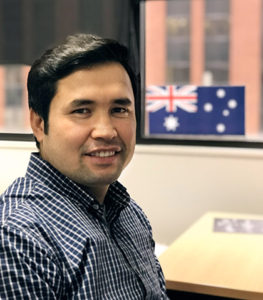My journey to Aussie
By Barat Ali Batoor
On April 5, 2012, when the Washington Post published my photo essay on the exploitation and sexual abuse of children in Afghanistan on its front page, I was extremely happy about it.
 I really felt that I was doing something important and the issues that I wanted to highlight were being heard and seen around the world.
I really felt that I was doing something important and the issues that I wanted to highlight were being heard and seen around the world.
But I didn’t realise consequences would be for me. After publication, everything changed dramatically and, in a matter of days, I was a displaced person.
I had to leave Afghanistan for my safety. That meant I had no job, no security and an uncertain future.
I never thought that I would travel so far away from my homeland to seek refuge. I had to cross borders illegally, sometimes hiding, sometimes escaping and sometimes giving up all hope.
After almost drowning at sea with 92 other asylum seekers en route to Christmas Island, I didn’t know what future held for me.
Living in limbo in Indonesia without a proper legal status, without any basic rights and work rights was a constant struggle for survival.
My sense of belonging was lost. During my time in Indonesia as an asylum seeker, two events were remarkable and positive and will always stay with me.
The first was when I got my status as a refugee from the UNHCR, and the second was when Australia accepted my application for resettlement.
In May 2013, I came to Australia on a Humanitarian visa. This country has given to me a lot since I have arrived. I have found safety and security and freedom from any fear.
I could call this new country my home. Finally, there was somewhere on earth where I could say this is the final stop. I don’t have to run any more to look for safety.
After four years of living in Australia, I was eligible to apply for the Australian citizenship in 2017.
The process used to be a lot quicker but, unfortunately, it took just more than two years for me to get a call for a citizenship test. My test was scheduled on the 29 July, 2019. I was very excited about it.
I searched online for materials to prepare for the test. The test was comprised on the three categories: Australia and its people; Australia’s democratic beliefs, rights and liberties, and; government and the law in Australia.
One of the questions which I found very interesting was about the history of the aboriginal people of Australian living on the mainland and in Tasmania for 40,000 to 60,000 years.
Another useful piece of information was to know about the Golden Wattle as national flower and the use of those colours in national sport jerseys.
I found many of the questions to be very simple yet very informative; things that we would take for granted in our daily lives but which are very useful and important.
I practiced the test a couple of times and it seemed pretty easy. The hardest part for me was to memorise some important dates and numbers as I am not good in remembering things
On the day, I arrived at the Department of Home Affairs office in Melbourne’s CBD around 30 minutes early and waited outside the building until we were called in.
There were few other people as well who also had their tests scheduled that day. We checked in and went onto the 2nd floor and waited for our turn.
My ticket number was called and I went to a lady who reviewed my documents. As I had many documents so it took a bit long for her to check all of them.
While she was reviewing my documents, we also had a brief chat about other stuff including Bollywood actors and movies.
She was from an Indian background that is why we had a common topic to chat about. Once the documents were verified, she took me to another room for the computer test.
I had 45 minutes to answer all the 20 questions. It was very easy and I finished it in approximately 5 to 10 minutes, scoring 100 per cent.
I returned to my office happily and now I am waiting for the department to finalise and call me in for a ceremony.
Overall, the whole experience was very good. I felt very much like this was moment that I became an Aussie.
As a photographer, I want to travel around the world to tell stories. But, with my current passport status it is almost impossible to get a visa for most of the countries I want to visit.
With the Australian passport I won’t have that problem and I will be able to travel without any issues.
I am already liking the feel of that freedom. And finally, I will be able to practice my true democratic right for the first time. I will have a role in choosing a representative.
Barat Ali Batoor is an award winning photographer. He came to Australia as a refugee after fleeing death threats in Afghanistan stemming from his work as photographer for the western media.
In 2014, Batoor won two Walkley Awards for photos he captured on an asylum seeker boat journey from Indonesia.












